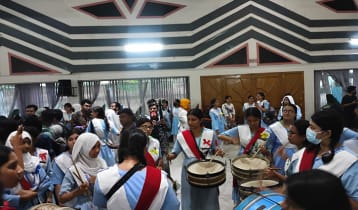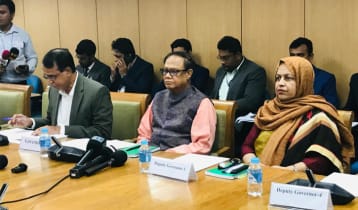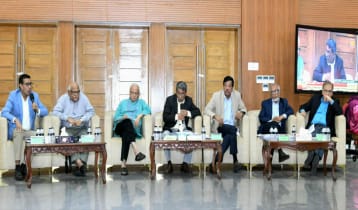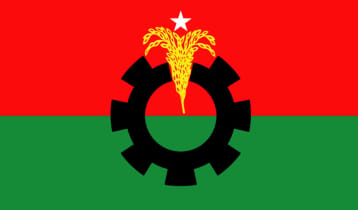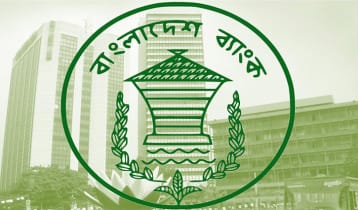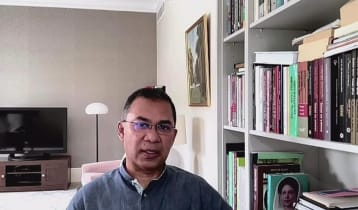Book Review: Bhandare Tabo Bibidho Ratan
News Desk || risingbd.com
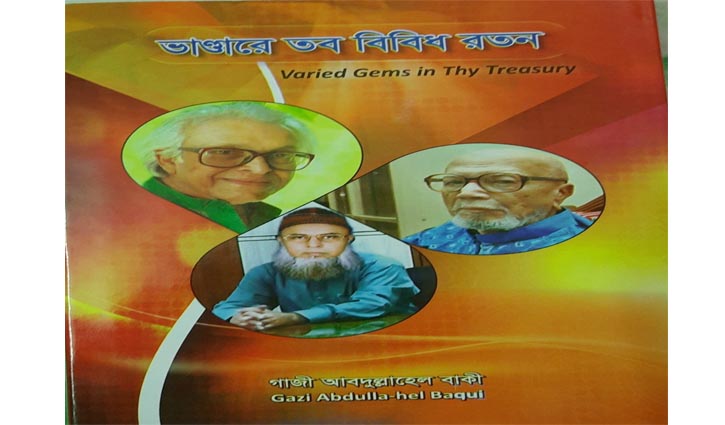
Bhandare Tabo Bibidho Ratan by Gazi A. H. Baqui
(A Bi-lingual book of sonnets by three sonneteers)
Reviewed by:
Umme Kulsum Keya
Adjunct Faculty of English
Khulna Khan Bahadur Ahsanullah University, Khulna
Editing and Translation: Prof. Dr. Gazi Abdulla-hel Baqui
Publisher: Nahar Publications, Khulna, Bangladesh
Cover Design: Md. Rashidul Islam (Setu)
Number of Pages 144, Hard Cover, Price: TK.-180/- US $ 5
ISBN: 978-984-34-3555-2
Bhandare Tabo Bibidho Ratan, or Varied Gems in Thy Treasury is a bi-lingual book of sonnets by Shamsur Rahman, Al Mahmud and Gazi Abdulla-hel Baqui. The book contains both Bangla and English titles as shown above. The translator has taken 15 sonnets of Poet Shamsur Rahman, Sonali Kabin (a book of 14 sonnets) by Al Mahmud and 15 sonnets of Gazi Abdulla-hel Baqui. The exhaustive introductions to the sonnets of Shamsur Rahman, Al Mahmud and Gazi Abdulla-hel Baqui are written by Dr. Rubel Ansar belonging to Bangla Discipline, Khulna University, Khulna, Dr. Mian Md. Nausaad Kabir from The English Language Department, Modern Language Institute, The University of Dhaka and Prof. Dr. Ashraful Karim to Bangla Department, Shahjalal University of Science and Technology, Sylhet respectively. Indeed, this sort of publication of highbrow literary productions is rarely found in our country and the editor and translator Baqui has made his strenuous attempts quite successful.
Dr. Rubel Ansar wrote the introduction for Shamsur Rahman’s sonnets. In the introduction he has illustrated the writing style of the poet and has portrayed the picturesque of his mastery to use liberal humanism, the emergence and consequent events of Bangladesh, human relations and romanticized rebellion of youth in his sonnets. He describes Shamsur Rahman as the main poet of Bangladesh. In addition, he has shown the constant changing artifice and techniques of his sonnets and how he has brought a strategic change to tastes and flavours to the contemporary literature. Rubel Ansar pointed out all the subject matters, ground work and structures of Shamsur Rahman’s sonnets in the introduction while praising his poetic justice.
Dr. Mian Md. Nausaad Kabir, in his introduction to Al Mahmud’s sonnets, has addressed the motive and idea behind the title of Sonali Kabin. He has disclosed the representation of ‘cultural materialism’ in the sonnets. Kabir, in his introduction, has compared the themes of the sonnets with the concept of feminism and Darwin’s concept of the ‘the survival of the fittest’. According to him, the poet’s pride is in his being an original Bangalee and his portrayal of the cultural life of Bangla in Sonali Kabin suggests a pure cultural practice combining past and present.
Prof. Dr. Ashraful Karim has written the introductory part for Gazi Abdullah-hel Baqui’s sonnets. Karim has designated him as a contemplative enlightenment soul of Bangla literature. He has found the combination of imagination and love in his writings. In his opinion, the poet is imbued with the consciousness of tradition. He expects from the poet to enrich his sonnets with special diction, rhythm, image, tone and taste which will be accepted by all corners as unique and wonderful pieces of poetry.
While translating the sonnets, Dr. Baqui has used literal translation style following GTM (Grammar Translation Method) to keep the beauty and originality of Bangla language. He has translated the inner meaning wherever it is necessary without completely changing the actual meaning. Images, figures of speeches, diction etc. can be preserved to ensure the true beauty and elegance as well as the aesthetic elements of Bangla language. He has introduced personification, allusion, metaphor, antithesis etc. which are the major concern to work on the literal translation. On the other hand, expressive translation requires only the translation of the inner meaning which Dr. Baqui does not support at all rather; he has more focused on maintaining the originality of the text by keeping in mind GTM.
Sonnet, derived from `sonnetto’, is an Italian form of fourteen lines poem originated by Petrarch. This form of poetical expression was at first introduced into Bangla literature by Michael Madhusudan Dutta. Since that very time, this excellent literary expression in the form of sonnet has been attempted by many, but mastered by few. In Bangla literature, we have a large number of sonnets composed by a good number of poets having different degrees of perfection. Many of them have been translated into English.
The present book titled Varied Gems in Thy Treasury under review contains a number of sonnets composed by three poets of Bangla literature—Shamsur Rahman, Al Mahmud and Gazi Baqui. This review is a study of the content and context, the style of composition, language, sound and rhythm, structure etc. shown from different perspectives in the sonnets of these three poets.
In Bangladesh, sonnet has become a favourite subject to the scholars as well as the heedful readers because of the fact that sonnets deal with multiple subject matters having different literary devices in a beautiful framework. However, sonnets that are included in Varied Gems in Thy Treasury give us an account of different styles of composition, language, sound and rhythm, structure in the way of representation.
Shamsur Rahman is a modern poet of Bangladesh, also known as “Nagar Kabi” as his verses are the vivid portrayal of modern city life. Through his sonnets he exhibits assorted social incongruities of the society. Besides, the romance of life, love for nature, glorifying women etc. have been narrated through eloquent expression. The city of reminiscences “Dhaka” has been regarded most rhetorical in his writing. The city gives him the ultimate shelter from all the miseries of life. This mysterious yet wondrous city is the source of a kind of pure joy to him though he has pointed out many imperfections of the city. Being possessed by his outlook of the ordinary vision, he has brought his “Gauri” to fulfil his poetic consciousness. Having the same artistic taste and abilities like Jibananda Das, he painted this female character in his sonnets. Through her presence in his sonnet, the poet expresses his emotions, feelings, different irrelevances of the society and state, injustice and adultery. In addition, the pains of city life, disappointments, emotions and feelings of the individual, unfading beauty of the country villages, various customs, reparation, socio-politics etc. are dealt with profound thought in his sonnets like ‘My Eyesight’, ‘The Memory of a Fish’, ‘Invoking You and You’, ‘Prose Sonnet: 1’ etc.
Shamsur Rahman wrote many sonnets and fourteen lined poems. A sonnet and a fourteen lined poem are not the same thing because a poem having fourteen lines does not always fulfill the conditions of a sonnet. The poet has written some prose sonnets. These sonnets are replete with beautiful images and figures of speeches like personification, metonymy, onomatopoeia, simile, metaphors etc. Rahman is called a city poet but natural beauty of our country and villages has been portrayed beautifully in his sonnets with sparkling images like, ‘the old tank of the village’, ‘red lotus’, ‘densely leafy green trees’, ‘soft whistle of doel’, ‘the rural wife’s bathing in the pond water’, ‘brown yellow coloured calf’ etc. His love for nature is reflected in the following verse:
the age-old tank is sleeping calmly, the red lotuses are floating in different directions of dreams.
The Gentle whistle of doel is sounded
Breaking through the dizziness of densely leafy trees nearby.
Rahman generally follows the modern western tradition of using words. His poetry marks the blend of The East and The West. He is called ‘the poet of equity of dual methods.’ (Nausaad/Baqui, 19) The poet did not believe in any magic of choosing words. He generally used words side by side of different languages without any hesitation.
Al Mahmud, the composer of the memorial piece Sonali Kabin is one of the most leading poets of Bangladesh. Through his wonderful aesthetic poetic excellence, he takes us to the world of rank reality and at the same time to the height of imagination. The magic of his writings keeps the readers spellbound. To the arena of modern Bangla poetry, he has an inestimable contribution. His fourteen unforgettable multi layered sonnets presented in Varied Gems in Thy Treasury are the invaluable contribution to Bangla as well as world literature. The subject matters of the sonnets are mainly love, desires, nature, worldly life, relationship between man and woman, society, history, country life, tradition, awareness of patriotism, pastoral culture and convention, keenness of modern intellect, evaluation of thoughts and ideas etc. The true picture of marital life in the spectrum of pastoral cultural setting has been portrayed in his sonnets. Cultural materialism is one the major themes of his sonnets. In the very first sonnet, he shows his wound caused by cultural materialism but also disclosed his strength towards it. He believes that the relationship between husband and wife rests on equality. Al Mahmud, following the same path of Keats, offers his beloved several poems, deemed as valuable as gold as a dowry in his marriage contract. In this very modern society of Bangladesh, the custom of this marriage contract is acutely accused of its application, and despicable commercialization. But the poet protests very humbly against the present maltreatment of this holy system. So, he requests his wife to take these sonnets as a cordial gift and symbol of his deep feelings towards her. These sonnets are his one type of ‘Kabin’. This is the mystery behind the title Sonali Kabin.
Al Mahmud, on the other hand has shown his creative craftsman in employing various figures of speech and images very appropriately like allusion, simile, metaphor, personification, oxymoron etc. He has presented both classical and traditional methods. In rhyme scheme pattern of his sonnets, he followed Petrarch, Shakespeare and his own model and method. He has successfully blended both the styles of Shakespearean and Petrarchan models of composing sonnets. Some of his sonnets have created Spenserian rhythmic pattern. The flow of rhythm and freedom of choosing appropriate words and phrases in composing sonnets are very prominent in his sonnets. He has his own poetic diction. The flow of magical sonority and wonderful craftsman has made his sonnets more charming. All of his sonnets are embroidered with different elements like nature, beauty, wonder etc.
A meditative literary personality Gazi Abdullah-hel Baqui is at large a poet, writer, critic and translator in modern Bangla literature.
He is a well-known Rubai composer and a sonneteer and such vocation has taken him to a considerable level as a literary personality. Various subject matters have intruded into his sonnets that are incomparable to his other literary output. In his sonnets, we can find the representation of love, beauty, imagination, inspiration for poets, instincts, nature, human heart, materialistic approach to life, philosophy etc. Themes of poetry, love and beauty have become significant in his sonnets. One of his sonnets is based on ‘Rubai’. He believes that true genuine love is the inspiration and also paves the way for gaining the eternal love. According to him, pain comes with love and poem comes with pain. In his sonnets he has shown his interests on imagination and love which have immeasurable power and they generate fertility in a poet’s poetic faculty. The poet expresses his earnest desire to create beauty in his verses by diving into the ocean of love. ‘Anindita’ as if becomes the mermaid of that ocean and it might be his inspiration and the product of his imagination. Rather than any worldly beauty, an immeasurable celestial beauty becomes more momentous in his poetry. He thinks if he succeeds in quest of celestial beauty, a beauty more beautiful than the beauty of ‘Anindita/, will be revealed and this perhaps exists only in feelings and imagination.
Baqui has written his sonnets following his own poetic style. His sonnets are generally divided into two parts: octave and sestet, mainly the style of Petrarchan sonnet, also known as Italian sonnets. The octave generally introduces a problem and the sestet completes it in a solution or resolution. In Baqui’s sonnets, we especially see the conscious glorification of his own tradition.
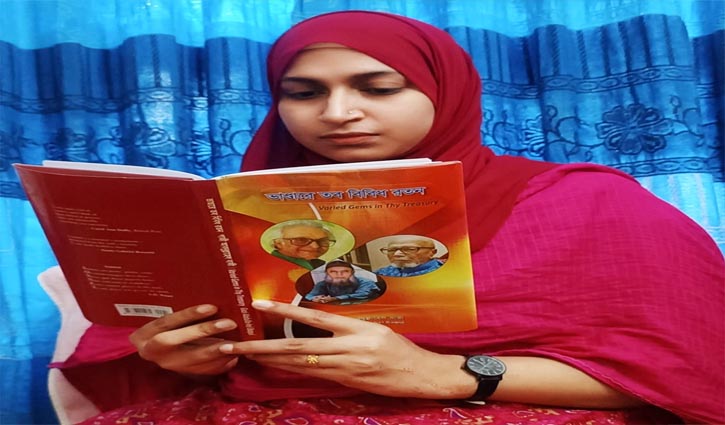
For Example:
In Baishakh Rabi sounds its soft tone’come, oh Baishakh’,
Creations are there in Bangla at the vast bower of new beauty; it seems
The fall of meteors in Pretilata’s Bangla not stopped afar,
Yet sloth never lies with Titumir, Netaji sings plying oars, who knows
When halcyon days come? Is there anybody like Bangabandhu?
Nightmare is not oblivious; when Doomsday ushers with the blow of Israfil’s horn.
(Baqui, 112)
He has used many words from local dialects to give a “photographic shape” (Baqui, 111) to his writing. His sonnets are adorned with special diction, rhythm, figures of speech, images, tone and taste.
In Shamsur Rahman’s sonnets, we see the presentation of different languages, specifically different words of various languages like Arabic, Persian and some other foreign tongues. In fact, the poet has followed western modernity in thrusting words into the context of using words. He has not followed the traditional poetic language of Kazi Nazrul Islam, Farrukh Ahmed or Syed Ali Ahsan. He has created his own domain of poetic language and imagery. Rahman has not shown any perplexity in his language usage rather he is very straightforward in choosing his words in all of his sonnets. He generally avoids all types of complexity to make his poems understandable to all types of readers but he is very conscious about the fineness in his verses to euphonize his poems. Most of his sonnets are written without following any general sonnet structure, specially his prose sonnets. These ‘prose sonnets’ are fourteen lined poems but have no structured arrangements.
For example:
Your perturbations striking against the walls
at night turned into dust and dropped
on the silent floor, and I collecting those
tiny fragments made a wreath of flowers.
(Baqui, 33)
Most of his sonnets are divided into octave and sestet. But there are some exceptions. In ‘Prose sonnet: 15’, the first part of the poem has ten lines followed by four lines in the second stanza. Some poems have followed abba cdcd efef gg structure. Some are written in abba cddc efgefg structure. And his ‘Prose sonnets’ don’t follow any traditional structure without having fourteen lines.
The title Sonali Kabin says a lot about Al Mahmud,s mastery of using language and showcasing the hidden meaning. The blending of two different words finds multiple connotative meanings in different state of affairs. In Sonali Kabin, gold is used to glorify women’s beauty, specifically his beloved. The pristine quality of gold makes both women and poems beautiful, charming and glittering. Kabin is completely different thing which legalizes marriage under Muslim law. In Muslim marriage it provides social security to the brides. The poet makes a bridge between these two to show his dedication in love. We find that his presence is romantic but he is not an escapist. He basically wants his present culture to be freed from all sorts of wrong features. The Indian critic Shibnarayan Roy said about him:
Al Mahmud has an extraordinary gift for telescoping discrete levels of experience; in his poems I find a marvelous fusion of passion and wit which reminds me occasionally of Bisnu Dey. (Baqui, 65)
In structure, like Shamsur Rahman, Al Mahmud also has shown the blending of different styles of composing sonnets. Shakespearean, Petrarchan and Spenserian rhythm has got a flow in his writing. He has maintained maximum freedom in choosing words and phrases in composing sonnets like Shamsur Rahman. He creates his own poetic diction. At the same time, he has used colloquial and modern Bangla, Arabic, Persian and many other languages. Using different words cast in semantic behavior of language makes him traditional as well as a modern poet. Using different figures of speech decorate his sonnets and also give it an organized appearance. His use of imagery gives his language a different level. Dr. Mia Nowshad Kabir has told about Al Mahmud’s poetic language:
“His sublime poetic lines and elaborate care in maintaining thematic unity remind us of Highbrow literature what his sequence of sonnets belongs to.”
The use of language in Al Mahmud’s sonnets reminds us our culture, custom and heritage of being the successoral of Pal, Sen, Goutam Buddha and Bakhtiar. That is why different words from different languages do not create any obstacle in the flow of poetic note and tone, rather it gives it a multiplicity in application. His way of using Periphrasis, Alliteration, Assonance, Oxymoron, and Allusion has made his poetry more aesthetic.
For example: Has the cotton fruit burst out of my house?
Put on the garland of red- black seed, O girl, dear Sabari.
Tell me, where you have kept the earthen pot of Mahua
bring it and let us be satisfied with its taste in the moonlight.
(Baqui, 81)
Baqui has shown his competence of using various subject matters in his sonnets and he believes in creating beauty in verses through imagination. His sonnets are accomplished with different types of figurative languages, such as simile, metaphor, antithesis, personification allusions etc. His sonnets are generally divided into two parts: octave and sestet. In some poems he has followed abab cdcd efef gg pattern and in some places he has structured his sonnet following abba cddc efef gg pattern. Again some of his sonnets have no rhythmic structure but having fourteen lines for categorizing them as sonnets which can be called “fourteen-lined poems” just like Shamsur Rahman’s prose sonnets. Historical characters of Bangladesh, legendary figures, elements from Greek Mythology, etc. are very noticeable in his sonnets. He has portrayed the figures like Isa Kha, Sirajuddoula, Protapaditha, Basanta Roy, Khudiram Bose, Nazrul, Jibananda Das, Rabindranath Tagore, Titumir, Netaji Subhsh Chandra Basu and some other historical figures of Bangladesh in his sonnets. He wrote a poem on ‘Rubai’, four lined stanza poem rhyming aaba. The poet has a great affection to these simple-styled poems and we can find its reflection in his sonnets. His sonnets project simple appearance yet profound meanings. In the sonnet 6, we find a character named Narcissus which has a great importance in Greek mythology. To talk about his imaginary beloved ‘Anindita’, he has taken shelter in Greek Mythology. It makes the poet neoteric and impulsive at the same time. In sonnet 15, He has mentioned American poets Langston Hughes and Amiri Baraka to glorify them in an unusual way.
He said: Langston Hughes, Amiri Baraka—what do they want?
They hoist the flag of victory awakening the meditative poetry.
(Baqui, 143)
In conclusion, it can be said that all of sonneteers mentioned in this bi-lingual book Varied Gems in Thy Treasury are rich in their own domain. The poets have projected their own style and own way of thinking. Though they have so many differences in composing sonnets, they all are tied with one thread as they all belong to Bangla Literature and the glorification of the natural beauty and Bangladeshi female beauties are highlighted in their sonnets. Their sonnets are the invaluable contribution to Bangla as well as the world literature.
Dhaka/Mukul







